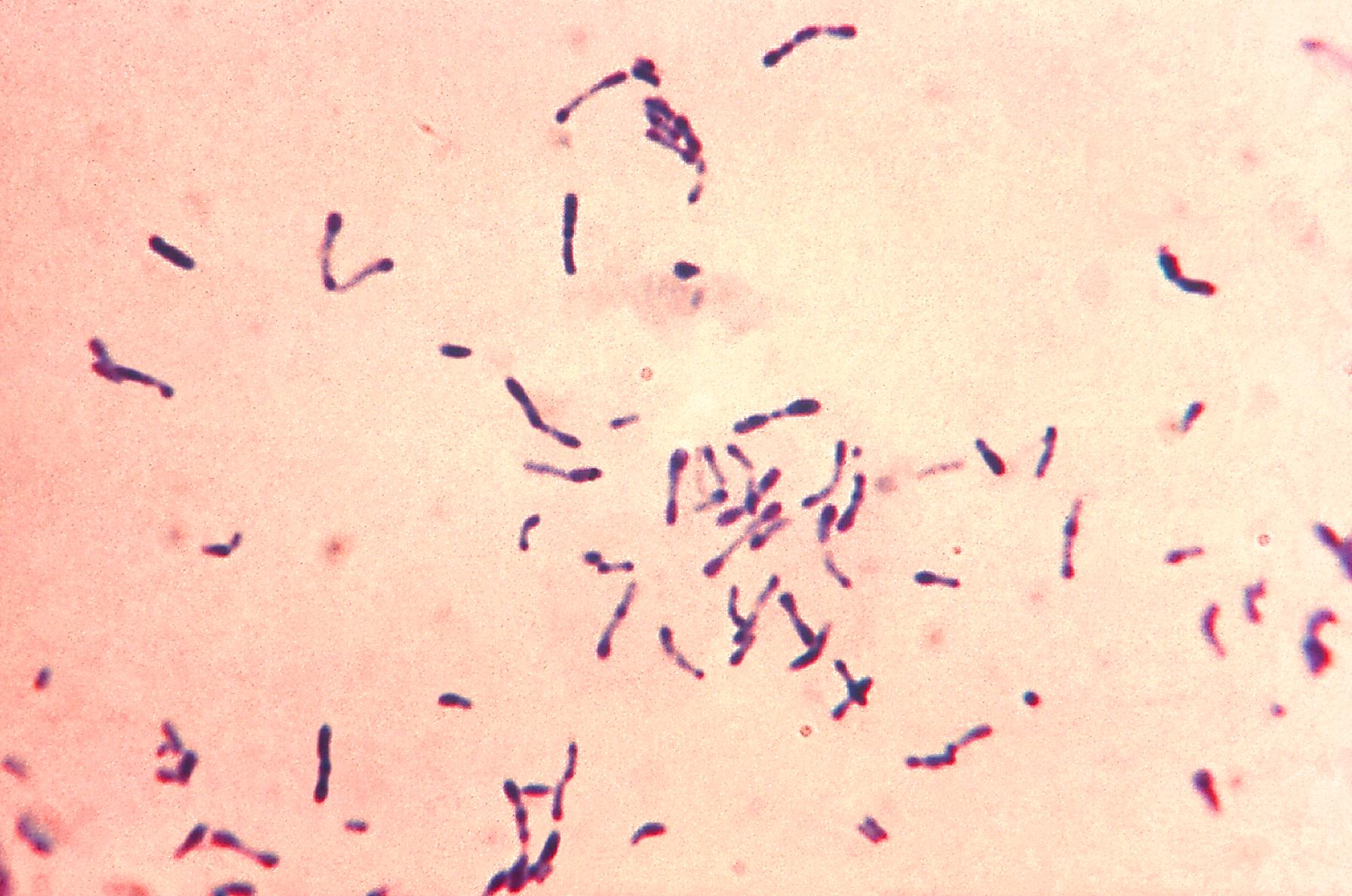Corynebacterium diphtheriae
|
Diphtheria Microchapters |
|
Diagnosis |
|---|
|
Treatment |
|
Case Studies |
|
Corynebacterium diphtheriae On the Web |
|
American Roentgen Ray Society Images of Corynebacterium diphtheriae |
|
Risk calculators and risk factors for Corynebacterium diphtheriae |
Editor-In-Chief: C. Michael Gibson, M.S., M.D. [1]; Associate Editor(s)-in-Chief: Luke Rusowicz-Orazem, B.S.
| Corynebacterium diphtheriae | ||||||||||||
|---|---|---|---|---|---|---|---|---|---|---|---|---|
 Gram stained Corynebacterium diphtheriae culture
| ||||||||||||
| Scientific classification | ||||||||||||
| ||||||||||||
| Binomial name | ||||||||||||
| Corynebacterium diphtheriae Kruse, 1886 |
Overview
Corynebacterium diphtheriae is a pathogenic bacterium that causes diphtheria. It is a facultatively anaerobic, gram positive organism characterized by non-encapsulated, non-sporulated, immobile, straight or curved rods. The genome of C. diphtheriae contains 2,488,635 nucleotides, 2,389 genes, and 69 structural RNA genes. Gram-stain will result in a blue-purple coloration due to containing polymetaphosphate granules. Many strains of C. diphtheriae produce diphtheria toxin, a protein exotoxin, with a molecular weight of 62 kilodaltons which ADP-ribosylates host EF-2, resulting in the inhibition of protein synthesis and producing signs of diphtheria. C. diptheriae is exclusively pathogenic in humans. C. diphtheriae can be classified into following four subspecies: mitis, intermedius, gravis, and belfanti. The diagnosis of C. diphtheriae includes a Gram stain procedure; results will indicate gram-positive, pleomorphic bacteria that will dye violet-blue and resemble clubs. C.diphtheriae causes diphtheria disease in non-immunized human hosts via secreted toxins. Toxigenic strains of the bacterium will secrete toxins in nasopharyngeal or skin lesions. It is common for hosts to carry C. diphtheriae in the nasopharyngeal region without displaying symptoms. Lysogenic conversion of nontoxigenic-toxigenic phenotypes of the bacterium can occur following transmission, allowing non-human/affected hosts to transmit diphtheria to humans. C. diphtheriae is sensitive to antibiotic therapy.
Morphology and Structure
- C. diphtheriae is a facultatively anaerobic, Gram positive organism that is characterized by non-encapsulated, non-sporulated, immobile, straight or curved rods.[1][2]
- The genome of C. diphtheriae contains 2,488,635 nucleotides, 2,389 genes, and 69 structural RNA genes.[3]
- As a gram-positive bacteria, C. diphtheriae contains a cell membrane and a lipid-rich murein layer outside.
- Cell wall sugars of C. diphtheriae include arabinose, galactose, and mannose.
- Gram-stain will result in a blue-purple coloration due to containing polymetaphosphate granules.
- Many strains of C. diphtheriae produce diphtheria toxin, a protein exotoxin, with a molecular weight of 62 kilodaltons which ADP-ribosylates host EF-2, resulting in the inhibition of protein synthesis and producing signs of diphtheria.[4]
- The inactivation of this toxin with an antitoxic serum (antitoxin) is the basis of the antidiphtheric vaccination.
- Not all strains are toxigenic; the ability to produce the exotoxin is conferred on the bacterium when it is infected by a bacteriophage through a mechanism termed lysogenic activation.
- A non-toxigenic strain can become toxigenic by the infection of such a bacteriophage.
- The inactivation of this toxin with an antitoxic serum (antitoxin) is the basis of the antidiphtheric vaccination.
- C. diptheriae is exclusively pathogenic in humans.[5]
Classification
C. diphtheriae can be classified into the following four subspecies:[1][2]
- C. diphtheriae mitis
- C. diphtheriae intermedius
- C. diphtheriae gravis
- C. diphtheriea belfanti[6]
Diagnosis
- The diagnosis of C. diphtheriae includes a gram stain procedure.
- Results will indicate gram-positive, pleomorphic bacteria that will dye violet-blue and resemble clubs.[6]
- Additional tests include Albert's stain and Loeffler's stain.
- C. diphtheriae should be cultured on an erichment medium, primarily to allow it to overgrow any other organisms present in the specimen.[7]
- A selective plate tellurite agar which allows all Corynebacteria (including C. diphtheriae) to reduce tellurite to metallic tellurium and produce brown colonies.
- C. diphtheriae is the only corynebacterium that will produce a black halo around the colonies.
- A selective plate tellurite agar which allows all Corynebacteria (including C. diphtheriae) to reduce tellurite to metallic tellurium and produce brown colonies.
Pathophysiology
- C.diphtheriae causes diphtheria disease in non-immunized human hosts via secreted toxins.[1][2]
- Toxigenic strains of the bacterium will secrete toxins in nasopharyngeal or skin lesions; it is common for hosts to carry C. diphtheriae in the nasopharyngeal region without displaying symptoms.
- A low concentration of iron is required in the medium for toxin production; at high iron concentrations, iron molecules bind to a repressor which shuts down toxin production[8]
- C.diphtheriae is transmitted through respiratory droplets, secretions, or direct contact.
- Lysogenic conversion of nontoxigenic-toxigenic phenotypes of the bacterium can occur following transmission, allowing non-human/affected hosts to transmit diphtheria to humans.
Sensitivity
C. diphtheriae is sensitive to the following antibiotics:[9]
- Benzylpenicillin
- Ampicillin
- Oxytetracycline
- Erythromycin
- Cephaloradine
- Lincomycin
- Clindamycin
- Neomycin
External links
- CoryneRegNet - Database of Corynebacterial Transcription Factors and Regulatory Networks
References
- ↑ Jump up to: 1.0 1.1 1.2 Baron S, Murphy JR (1996). "Medical Microbiology". 4. PMID 21413281.
- ↑ Jump up to: 2.0 2.1 2.2 Chang DN, Laughren GS, Chalvardjian NE (1978). "Three variants of Corynebacterium diphtheriae subsp. mitis (Belfanti) isolated from a throat specimen". J. Clin. Microbiol. 8 (6): 767–8. PMC 275340. PMID 106070.
- ↑ Cerdeno-Tarraga, A. M. (2003). "The complete genome sequence and analysis of Corynebacterium diphtheriae NCTC13129". Nucleic Acids Research. 31 (22): 6516–6523. doi:10.1093/nar/gkg874. ISSN 1362-4962.
- ↑ Nester, Eugene W.; et al. (2004). Microbiology: A Human Perspective (Fourth ed.). Boston: McGraw-Hill. ISBN 0-07-247382-7.
- ↑ von Behring E, Kitasato S (1991). "[The mechanism of diphtheria immunity and tetanus immunity in animals. 1890]". Mol. Immunol. (in German). 28 (12): 1317, 1319–20. PMID 1749380.
- ↑ Jump up to: 6.0 6.1 "Pinkbook | Diphtheria | Epidemiology of Vaccine Preventable Diseases | CDC".
- ↑ Nester, Eugene W.; et al. (2004). Microbiology: A Human Perspective (Fourth ed.). Boston: McGraw-Hill. ISBN 0-07-247382-7.
- ↑ Nester, Eugene W.; et al. (2004). Microbiology: A Human Perspective (Fourth ed.). Boston: McGraw-Hill. ISBN 0-07-247382-7.
- ↑ Zamiri I, McEntegart MG (1972). "The sensitivity of diphtheria bacilli to eight antibiotics". J. Clin. Pathol. 25 (8): 716–7. PMC 477485. PMID 4627747.